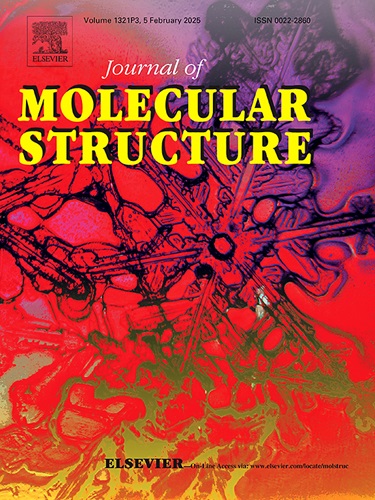Three Isomorphic Ln-MOFs: Structures, Preparation of Films, and Efficient Fluorescence Sensing
IF 4.7
2区 化学
Q2 CHEMISTRY, PHYSICAL
引用次数: 0
Abstract
The development of rapid, stable, and reusable portable fluorescent sensors is paramount for real-time environmental monitoring, public safety assurance, and enhancing analytical detection efficiency. In this study, dicarboxylic acid ligands 4,5-di(4′-carboxylphenyl)benzene (H2cb) and lanthanide salts were employed to synthesize three isostructural lanthanide metal-organic frameworks (Ln-MOFs) through hydrothermal method: {[Tb4(cb)6(DMF)(OH)2]·2DMF·4H2O}n(1), {Eu4(cb)6(DMF) (OH)2]·3DMF·11H2O}n (2), {Sm4(cb)6(DMF)(OH)2]·2DMF·8H2O}n (3), where DMF = N,N-dimethylformamide (C3H7NO). Comprehensive characterization through single-crystal X-ray diffraction, powder X-ray diffraction, infrared spectroscopy, thermogravimetric analysis, and fluorescence spectroscopy revealed that 1–3 crystallized in the monoclinic P21/c space group, featuring a novel 2D planar structure with exceptional thermal stability and high phase purity. Notably, 1 and 2 demonstrated outstanding luminescent properties. Through polymer-embedding methods, these Ln-MOFs were successfully fabricated into flexible fluorescent films (1@PMMA and 2@PMMA) exhibiting robust acid-base stability. Furthermore, the 1@PMMA film showed sensitive detection capabilities for lomefloxacin hydrochloride (LOMH) and cysteine (Cys), while 2@PMMA film displayed selective sensing toward sulfasalazine (SSZ), Cr₂O₇²⁻, and Fe³⁺, with detection limits of 0.35, 0.81, 0.18, 0.88, and 2.46 μmol/L, respectively. Most importantly, these films maintained excellent reversibility and stability through over 20 reuse cycles. This work provides a promising strategy for building luminescent platforms that can effectively identity various environmental pollutants.
三种同形ln - mof:结构、薄膜制备和高效荧光传感
开发快速、稳定、可重复使用的便携式荧光传感器对实时环境监测、保障公共安全、提高分析检测效率具有重要意义。本研究以二羧酸配体4,5-二(4′-羧基苯基)苯(H2cb)和镧系盐为原料,通过水热法合成了三种同结构镧系金属有机骨架(ln - mfs): {[Tb4(cb)6(DMF)(OH)2]·2DMF·4H2O}n(1)、{Eu4(cb)6(DMF) (OH)2]·3DMF·11H2O}n(2)、{Sm4(cb)6(DMF)(OH)2]·2DMF·8H2O}n(3),其中DMF = n, n-二甲基甲酰胺(C3H7NO)。通过单晶x射线衍射、粉末x射线衍射、红外光谱、热重分析、荧光光谱等综合表征发现,1-3在单斜P21/c空间群中结晶,具有新颖的二维平面结构,具有优异的热稳定性和较高的相纯度。值得注意的是,1和2表现出优异的发光性能。通过聚合物包埋的方法,这些ln - mof成功地制成柔性荧光膜(1@PMMA和2@PMMA),具有强大的酸碱稳定性。1@PMMA膜对盐酸洛美沙星(LOMH)和半胱氨酸(Cys)具有灵敏的检测能力,2@PMMA膜对磺胺嘧啶(SSZ)、Cr₂O₇²⁻和Fe³⁺具有选择性检测能力,检出限分别为0.35、0.81、0.18、0.88和2.46 μmol/L。最重要的是,这些薄膜在20多次重复使用中保持了优异的可逆性和稳定性。这项工作为构建能够有效识别各种环境污染物的发光平台提供了一种有前途的策略。
本文章由计算机程序翻译,如有差异,请以英文原文为准。
求助全文
约1分钟内获得全文
求助全文
来源期刊

Journal of Molecular Structure
化学-物理化学
CiteScore
7.10
自引率
15.80%
发文量
2384
审稿时长
45 days
期刊介绍:
The Journal of Molecular Structure is dedicated to the publication of full-length articles and review papers, providing important new structural information on all types of chemical species including:
• Stable and unstable molecules in all types of environments (vapour, molecular beam, liquid, solution, liquid crystal, solid state, matrix-isolated, surface-absorbed etc.)
• Chemical intermediates
• Molecules in excited states
• Biological molecules
• Polymers.
The methods used may include any combination of spectroscopic and non-spectroscopic techniques, for example:
• Infrared spectroscopy (mid, far, near)
• Raman spectroscopy and non-linear Raman methods (CARS, etc.)
• Electronic absorption spectroscopy
• Optical rotatory dispersion and circular dichroism
• Fluorescence and phosphorescence techniques
• Electron spectroscopies (PES, XPS), EXAFS, etc.
• Microwave spectroscopy
• Electron diffraction
• NMR and ESR spectroscopies
• Mössbauer spectroscopy
• X-ray crystallography
• Charge Density Analyses
• Computational Studies (supplementing experimental methods)
We encourage publications combining theoretical and experimental approaches. The structural insights gained by the studies should be correlated with the properties, activity and/ or reactivity of the molecule under investigation and the relevance of this molecule and its implications should be discussed.
 求助内容:
求助内容: 应助结果提醒方式:
应助结果提醒方式:


